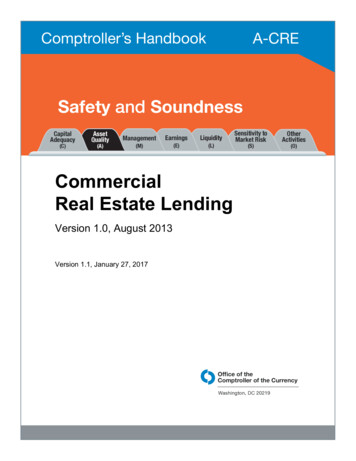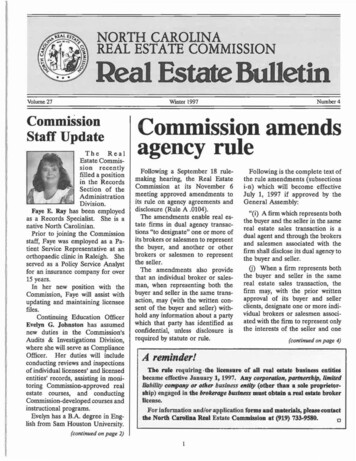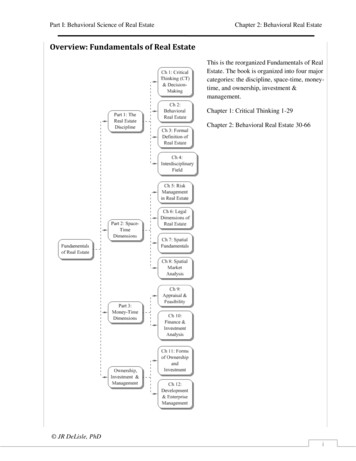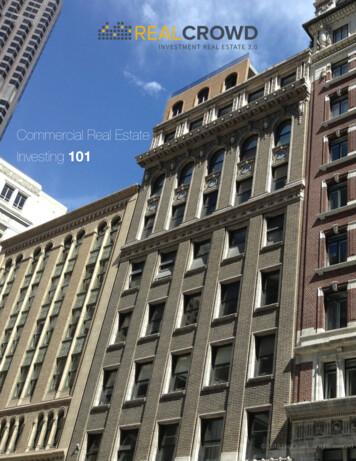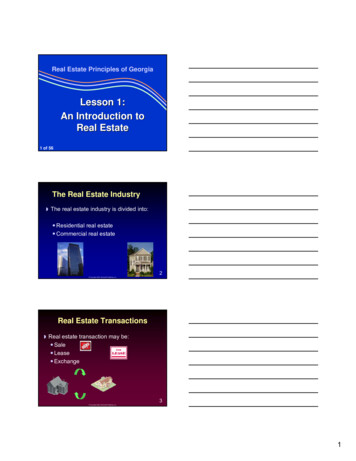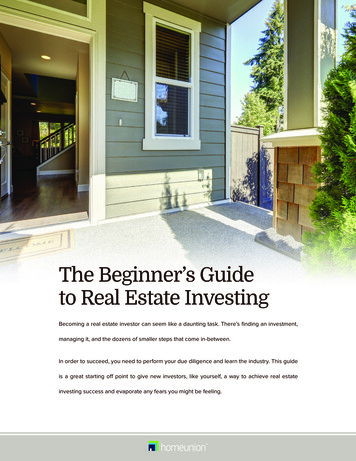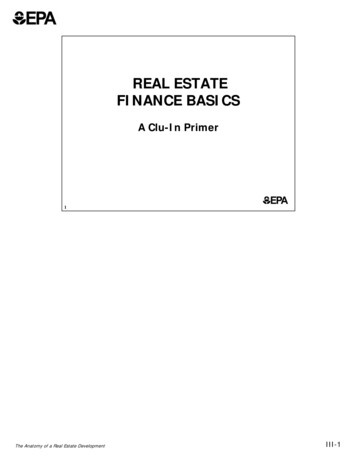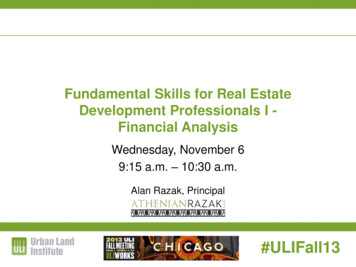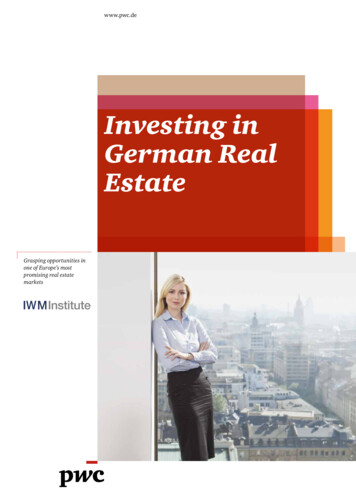
Transcription
NBER WORKING PAPER SERIESUNDERSTANDING COMMERCIAL REAL ESTATE:JUST HOW DIFFERENT FROM HOUSING IS IT?Joseph GyourkoWorking Paper 14708http://www.nber.org/papers/w14708NATIONAL BUREAU OF ECONOMIC RESEARCH1050 Massachusetts AvenueCambridge, MA 02138February 2009I thank Fernando Ferreira, Ed Glaeser, Peter Linneman, Asuka Nakahara, and Raven Saks for helpfulcomments on an earlier draft of this paper. Andrew Moore, Chae-Ho Shin, and Yu Zuo provided excellentresearch assistance. I also am grateful to the Research Sponsors Program of the Zell/Lurie Real EstateCenter at Wharton for its financial support. The usual caveat applies. The views expressed hereinare those of the author(s) and do not necessarily reflect the views of the National Bureau of EconomicResearch. 2009 by Joseph Gyourko. All rights reserved. Short sections of text, not to exceed two paragraphs,may be quoted without explicit permission provided that full credit, including notice, is given tothe source.
Understanding Commercial Real Estate: Just How Different from Housing Is It?Joseph GyourkoNBER Working Paper No. 14708February 2009JEL No. R0,R21,R31ABSTRACTRecent sharp declines in owner-occupied housing prices naturally raise the question of whether somethingsimilar will happen to income-producing properties. It already has based on the nearly 60% declinein the share prices of publicly-traded, commercial property firms from their peak in early 2007. Thecore model of spatial equilibrium in urban economics suggests this should not be a surprise, as it showsthat both real estate sectors are driven by common fundamentals, which should make them performsimilarly. On the other hand, stronger limits to arbitrage in housing suggest wider swings in pricesunrelated to fundamentals are feasible in that property sector. The data find many more similaritiesthan differences across the two real estate sectors. The simple correlation between appreciation rateson owner-occupied housing and commercial real estate is nearly 40%. Both sectors also exhibit similartime series patterns in their price appreciation, with there being persistence across individual yearsand mean reversion over longer periods.Commercial real estate capital structure looks to be quite weak due to high leverage combined withstrong mean reversion in prices. The aggregate loan-to-value ratio on income-producing propertiesis about 75%. Estimated mean reversion in price appreciation of at least 25% over relatively shorthorizons suggests that normal change from the recent peak will leave little or no equity on averageto cushion against any future negative shocks.Joseph GyourkoUniversity of PennsylvaniaWharton School of Business3620 Locust Walk1480 Steinberg-Dietrich HallPhiladelphia, PA 19104-6302and NBERgyourko@wharton.upenn.edu
I. IntroductionThe dramatic and unprecedented 18% decline in nominal house prices over the past yearfor 20 major markets tracked by the S&P/Case-Shiller Home Price Indices1, with futures marketspredicting similarly large drops in 2009, naturally raises the question of whether commercial, orincome-producing, real estate will follow a similar path. Public commercial property firmsalready have traded down sharply according to the National Association of Real EstateInvestment Trusts’ (NAREIT) index for such firms, as reflected in the 20-30% implied decline inthe values of their property holdings from their peak in February of 2007.2 Privately-heldcommercial properties have only recently begun to reprice down according to the NationalCouncil of Real Estate of Investment Fiduciaries (NCREIF) index for that subset of the incomeproducing sector, but past research suggests that there is more to come, as the public marketreliably leads the private market in commercial real estate over the cycle (Gyourko and Keim(1992); Gyourko (2005)).The large size of the commercial property markets combined with their high financialleverage makes their study important, especially given current weakness in the financial sector.One prominent industry source estimates that the investable universe of investment gradeproperties was nearly 4.8 trillion early in 2008, with about 3.6 trillion encumbered by debt ofsome type.3 Most income-producing properties are held privately, as equity REITs constitute1See the December 30, 2008, press release SHomePrice Release 123062.pdf.2Firm returns fell by nearly 60%, but the 40%-50% leverage typical of this part of the industry implies thatunderlying property values declined by about half that amount. These figures apply only to equity REITs that ownand operate income-producing properties.3See the Urban Land Institute’s Emerging Trends in Real Estate 2009 publication, Exhibit 2-8, p. 21. The termscommercial and income-producing real estate are used interchangeably throughout this paper. To be incomeproducing, the property cannot be owner-occupied, but must be rented out to tenants. ‘Institutional grade’ is not aprecisely defined term, but the publishers of this particular report intend it to cover high quality properties in majormarkets. Thus, this figure excludes various lower quality, often smaller properties, and those in smaller markets thatare relatively illiquid by real estate industry standards. However, it does include debt and equity capital for1
less than one-third of the overall equity investment in commercial real estate. The REIT sectoralso is less highly leveraged, typically having no more than a 1-to-1 debt-to-equity ratio (prior tothe recent sharp drop in share prices). Thus, the aggregate loan-to-value (LTV) ratio of 75%( 3.6/ 4.8) for commercial real estate indicates that leverage is even greater for privately-heldproperties. This far exceeds the analogous 55% figure in the owner-occupied housing market4,so that value drops of the magnitude already seen in the owner-occupied housing and equityREIT markets would wipe out most or all commercial real estate equity on average, leaving nocushion against any future adverse shocks.This paper investigates just how similar or different we should expect outcomes inowner-occupied housing and income-producing real estate to be. The analysis begins byexamining what urban economic theory and the bubbles literature in asset pricing have to say onthe issue. The data are then explored to see how outcomes vary across the housing andcommercial property sectors over time and by metropolitan areas. Various risk characteristics ofincome-producing properties also are documented and discussed.The standard spatial equilibrium model in urban economics predicts similar longer-runmovements in the different real estate sectors because each is driven by common fundamentals(Rosen (1979); Roback (1982)). However, the more stringent limits to arbitrage that exist in thehousing market seem to permit the possibility of swings in prices that are disconnected fromapartments because those units are rented out, and thus, are income-producing in the same sense that office or mallspace is. Owner-occupied housing is not included, just as owner-occupied office buildings and manufacturingfacilities are not. This is why this 4.8 trillion figure is much smaller than the amount of real estate on the balancesheets of non-farm, nonfinancial corporate and noncorporate businesses. According to the Federal Reserve Board’sFlow of Funds Accounts for the third quarter of 2008, there was 8.9 trillion of real estate owned by nonfarm,noncorporate businesses, with another 7.0 trillion on the balance sheet of nonfarm, noncorporate entities. [See theDecember 11, 2008, release of the Flow of Funds Accounts of the United States t/z1r-5.pdf.] Much of this property is owner-occupied.4The ratio for homeowners was only 45% in 2002, so housing-related leverage recently has risen substantially in thehousehold sector as mortgage debt expanded and home values then dropped. See the data in Table B.100 BalanceSheet of Households and Nonprofit Organizations from the December 11, 2008, Federal Flow of Funds statement,which is accessible at z1r-5.pdf.2
fundamentals (Glaeser and Gyourko (forthcoming)). This could break the link from commondemand fundamentals and allow market outcomes to diverge.Examining the data finds many more similarities than differences in how these sectorsbehave over time. Using annual data since 1978, the simple correlation between the appreciationrates for income-producing property and housing is nearly 40%. During the recent boom period,the greater the rise in the ratio of house prices to their construction costs in a given metropolitanarea, the larger was the rise in the analogous ratio for office buildings. The limits to arbitragewell may be less severe in commercial real estate, but the use of common productiontechnologies and factors of production such as land and capital probably makes it difficult toprevent pricing in one property sector from influencing values in another within the same marketarea.Both housing and commercial real estate have long, multi-year cycles, although thelatter’s is much more volatile. The time series properties of price changes in the commercialproperty sector also are quite similar to those previously reported for owner-occupied housing.There is persistence in price appreciation over short times periods, so that growth begets growth(and decline begets decline) from year-to-year in commercial properties, just as Case and Shiller(1989) documented for housing. However, there is substantial mean reversion over longerhorizons that is similar to what Glaeser and Gyourko (2006) report for housing. Results reportedbelow indicate that for every percentage point more that income-producing propertiesappreciated over the past three years, they will decline by 0.27 points over the next three years(always relative to national conditions and local market trend).It also is noteworthy how risky commercial real estate appears to be as the generaleconomy continues to decline. More than half of the rise in commercial property prices in the3
markets that boomed the most is due to an increase in the multiple investors placed on a givendollar of net rents, not rising cash flows themselves. That lenders, not just investors, becamemore enthusiastic about the commercial property sector is evidenced by the deterioration inunderwriting standards evident at the height of the boom. Requirements for commercial ownersto amortize their loans weakened considerably in recent years. And, the proliferation of ‘proforma loans’ in which hoped for, prospective rent increases were credited as if they werecertainties indicate that the belief that prices only could go up was not restricted to the subprimeand Alt-A home loan markets.Examination of office building transactions since 2003 for a sample of over 30 largemetropolitan areas finds that prices have risen sharply relative to fundamental production costs inabout one-third of them. This group includes many of the southern and sunbelt markets such asLas Vegas, Miami, Phoenix, and Tampa that experienced the greatest housing booms, and whichare now busting. It also contains the most restrictive markets in terms of building regulationsuch as Boston, New York City, and San Francisco. While these places where prices havediscretely diverged from production costs in a short period of time are natural candidates forrepricing, no firm conclusions about irrational exuberance can be reached regarding America’smajor office markets. No tests for bubbles are performed, nor could they be with the limited dataavailable (Flood and Hodrick (1990)). Urban economics suggests that some restrictive change insupply conditions or heightened productivity (or amenities) is needed to justify the larger gapsbetween prices and construction costs in these markets. Absent such changes, prices in thesemarkets should be expected to fall.Even without any irrational exuberance or the added risk of a serious general recession,the magnitude of mean reversion, the extraordinary nature of the recent boom, and the high4
financial leverage used in the commercial property sector would be cause for concern. Thepotential threat this combination could pose to the soundness of the banking system onlyreinforces the importance of increasing our understanding of the nature of the commercialproperty market cycles.The plan of the paper is as follows. The next section discusses the underlying economicintuition about why commercial real estate and housing should or should not move together.Section III then begins the empirical analysis, starting with basic documentation of the data andthe nature of commercial real estate cycles. This is followed in Section IV with an examinationof predictability in commercial property markets, which documents the short-run persistence andmedium-term mean reversion noted above. Section V then examines the role of local marketversus common effects in explaining returns and price changes. Section VI then documents andanalyzes a host of risk factors specific to the commercial property markets. There is a briefconclusion.II. Should Housing and Commercial Real Estate Move Together?The core model of spatial equilibrium in urban economics indicates that thefundamental sources of demand for both housing and commercial real estate are quite similar. Inthis compensating differential framework introduced by Sherwin Rosen and Jennifer Robacknearly three decades ago, land prices are the entry fee that households and firms must pay toaccess the productivity and amenities of a labor market area. Higher land values have to be paidto enter a metropolitan area with more productive firm clusters or nicer weather. Because land issubstitutable on the margin between uses, the prices of both residential and commercial propertywill move together if local productivity or the amenity set ch
that both real estate sectors are driven by common fundamentals, which should make them perform similarly. On the other hand, stronger limits to arbitrage in housing suggest wider swings in prices unrelated to fundamentals are feasible in that property sector. The data find many more similarities than differences across the two real estate sectors. The simple correlation between appreciation .

